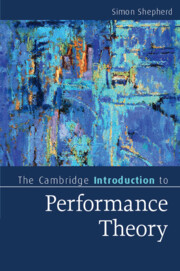Book contents
- Frontmatter
- Contents
- Preface
- Part I Definitions of performance
- Part II The emergence of performance as sensuous practice
- 6 Situationism, games and subversion
- 7 Hippies and expressive play
- 8 Performance as a new pedagogy
- 9 Architecture and the performed city
- 10 New forms of activism
- 11 Happenings and everyday performance
- 12 Body art and feminism
- 13 The arrival of Performance Art and Live Art
- 14 Dance party politics
- Part III Theorising performance
- Closing note
- References
- Index
- Cambridge Introductions to …
9 - Architecture and the performed city
from Part II - The emergence of performance as sensuous practice
Published online by Cambridge University Press: 05 February 2016
- Frontmatter
- Contents
- Preface
- Part I Definitions of performance
- Part II The emergence of performance as sensuous practice
- 6 Situationism, games and subversion
- 7 Hippies and expressive play
- 8 Performance as a new pedagogy
- 9 Architecture and the performed city
- 10 New forms of activism
- 11 Happenings and everyday performance
- 12 Body art and feminism
- 13 The arrival of Performance Art and Live Art
- 14 Dance party politics
- Part III Theorising performance
- Closing note
- References
- Index
- Cambridge Introductions to …
Summary
While Hunt was working at Bradford, across the Channel spaces had been forcibly occupied in a new and spectacular way, offering an image of a new way of being. In May 1968 the streets and buildings of Paris were taken over by students and workers as a challenge to dominant order. To René Viénet it seemed that: ‘Capitalized time stopped. People strolled, dreamed, learned how to live.’ And with it the very fabric of the city was itself transformed: ‘red and black flags gave a human appearance to the fronts of public buildings. The Haussmanian perspective of the boulevards was corrected and the green belts redistributed and closed to traffic. Everyone, in his own way, made his own critique of urbanism’ (in Pinder 2005: 236).
‘Urbanism’ was from the start a topic of interest to those people whose ideas hovered behind – they would say shaped – the events of 1968, the Situationists. They saw the habitual structure and functioning of the city as a concrete manifestation of the alienating system of commodity exchange. In itself of course a concern with the city's effect on its inhabitants is neither new nor remarkable. Such concerns have probably existed as long as cities have. In the fashion for so-called city comedy in the London of the 1590s there was an interest in the sorts of behaviour that seemed to be produced by, and in response to, new mercantile wealth, behaviours facilitated by the spaces and living conditions of the city. In the mid-nineteenth century Engels suggested that the dynamic of the crowd was a characteristic feature of the city, and it was that presence which persisted into Walter Benjamin's early twentieth-century conception of a particular city type defined as an individual in separation from the crowd, the flâneur. More or less contemporary with Benjamin's sketching of the flâneur, Simmel characterised the mind-set of the crowd as a specifically urban product, shaped by the rhythm of city behaviours and interactions. In some ways, of course, this is not too far distant from the feeling that new rhythms were necessarily pressing on, and making themselves felt in, the late sixteenth century's rendering of the city as ‘comedy’.
The difference of the situationist approach to the city is that they wanted to change how the city worked, changing it materially if necessary.
- Type
- Chapter
- Information
- The Cambridge Introduction to Performance Theory , pp. 82 - 93Publisher: Cambridge University PressPrint publication year: 2016



